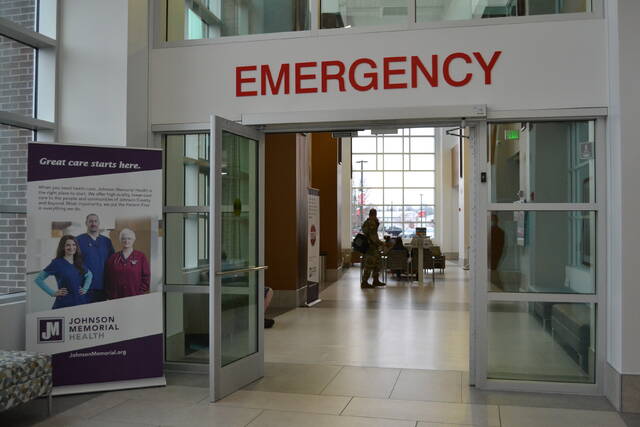Two years into the COVID-19 pandemic, local health officials are prepared for the ebb and flow of cases caused by new variants.
Cases of COVID-19 are on the rise in Johnson County, as are hospitalizations. Though the situation is still manageable and only a fraction of what the county has faced at other points of the pandemic, officials are guarded about what this recent surge could become.
“The thing that raises some trepidation is that the hospital has been pretty full over the past month, and this is a time, historically, when hospitals aren’t as busy in the summer months,” said Dr. David Dunkle, president and CEO of Johnson Memorial Hospital. “You do start to worry as you head into the fall and winter, when you see increases in other respiratory illnesses, will you have the beds to take care of those patients?”
Across the country, COVID-19 cases have been rising throughout the summer. The increase is fueled by a spike of BA.5 subvariant cases, which emerged in the United States in May. According to the Indiana Department of Health, 2,121 cases were reported across the state as of Aug. 11. In 22% of those cases, it was reinfection.
As of Aug. 11, Johnson County was reporting 68 total cases. The county is at a “high” risk level, during which the Centers for Disease Control and Prevention advises that people wear a well-fitting mask or respirator. People who are at high risk of getting very sick are also recommended to consider avoiding non-essential indoor activities in public where they could be exposed.
This month so far, there have been 860 cases reported in Johnson County, compared to over 1,300 in July, which could signal cases will surpass that total. Cases in the county have been increasing in number each month since the March lull when only 129 cases were reported in the county that month. That was a steep drop-off following the county’s all-pandemic high January infection rate of over 9,400 cases.
The latest numbers likely don’t illustrate the whole picture, said Betsy Swearingen, director of the Johnson County health department.
“We have seen a slight uptick in the number of cases. However, there is so much home-testing that it really isn’t an accurate depiction of the true number of cases that are out there right now,” she said. “If they’re taking an at-home test, I don’t think we’re getting accurate numbers for the cases we have right now.”
The county reported 20 new hospitalizations, as of Aug. 10. At Johnson Memorial Health, hospital officials are seeing an increase in people admitted, Dunkle said.
“The thing that’s most concerning from a health care provider standpoint is seeing more people whose primary diagnosis is COVID. They’re coming in with COVID pneumonia, hypoxia, diagnoses directly related to COVID,” he said. “Previous to this, we’d have people test positive for COVID, but that wasn’t why they were here. They were asymptomatic. But we’ve definitely seen a change in the last month.”
At this point, the surge is not threatening Johnson Memorial’s capacity; they still have available beds and space for all of the patients coming to the hospital, Dunkle said.
The increase in hospitalizations has made the existing nursing and staffing shortages more pronounced, though.
“We’re able to handle this now. But this whole country is facing a nursing shortage and labor shortage in general. It is tough,” Dunkle said.”When you see COVID circulating in the community more, that’s more of our employees that risk getting ill. And as illness circulates in schools, sometimes employees can’t work due to childcare issues.”
Because the hospital has been dealing with the pandemic for the past two years, they are supplied with all of the masks, personal protective equipment and other special precautions to deal with a surge in COVID, Dunkle said.
“From everything we’ve been through, we have the equipment. What you worry about is the labor,” he said.
In the face of a new wave of cases, many people seem to have discarded the guidelines and recommendations that health officials have touted for the past two years.
“I think a lot of people are just over it. They’re not following the safety protocols that we put in place two years ago, or even this time last year,” Swearingen said. “People aren’t being safe. If you’re sick, you need to stay home, get healthy and stay away from those you love so you don’t get them sick as well.”





